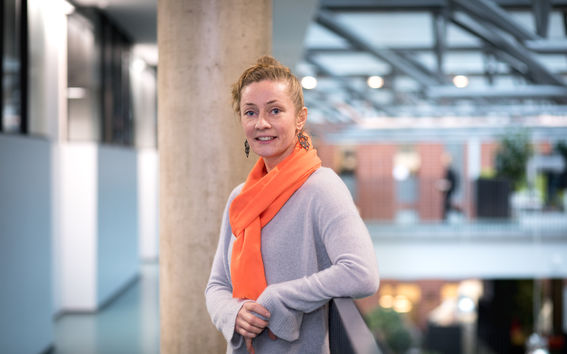A 'lifelong interest in coding' is not a requirement for seeking a career in technology

In the fall of 2007, Johanna Kaipio – then Viitanen – was watching the Finnish TV programme 45 minuuttia (“45 minutes”), when she had an idea that would change the course of her career. The episode in question dealt with the shortcomings of electronic health record systems used in hospitals. “I thought then that if the systems are so difficult to use, perhaps I could research them,” Kaipio says.
Kaipio has researched IT systems in healthcare for a decade now. In addition to academia, she has been involved in two extensive client and patient information system procurement processes. In September, she started working as a Professor of Practice at Aalto University’s Department of Computer Science.
Kaipio is interested in health and social care information systems because developing them through technical expertise is a way to help clients and patients in the healthcare and social welfare field. “I enjoy working with people from different backgrounds, such as physicians, nurses, and social care workers. It is a meeting point where the best new ideas and insights come together.”
When Kaipio was a child, her father (a Master of Science in Technology) and mother (kindergarten teacher) nudged her towards mathematical subjects. In addition to mathematics, her interests in upper secondary school also included psychology. It was this combination that led her to apply for the Department of Electrical and Communications Engineering at Helsinki University of Technology. “In my studies, I was able to apply my knowledge of both psychology and mathematics. User-centred design and usability are a natural continuation of this interest.”
Technology is present in all fields. Psychology and cognitive science are prime examples of where it can be seen. Kaipio emphasises that there are several different angles for approaching technology.
The industry could do with more female students. Currently, women make up less than a third of students in the field of technology. In computer science, the distribution is even more unbalanced. Kaipio would like to tell girls and young women that students in the field do not need to be ready experts or even particularly technology oriented. “A lifelong interest in coding is not a requirement for seeking a career in technology. Being enthusiastic about new things and interested in working with technology and information systems go a long way.”
Developing a single solution for various work environments is challenging
According to Kaipio, healthcare information systems have evolved in the last ten years, though there is still much be done. “Finland is a forerunner in many aspects, such as the utilisation of advantaged IT systems’ functionalities and health information exchange at the national level. This is often overlooked, as we are so critical of our own work.”
Particular critique has been directed at the Apotti project, which Kaipio also worked on during 2013–2015. The system was first introduced at Peijas hospital in the Hospital District of Helsinki and Uusimaa (HUS) in November 2018. Its use is now being expanded within HUS and the metropolitan area municipalities gradually until the end of 2020.
Although the project is considered costly and has been criticised, Kaipio reminds that Apotti is a pioneer project. It is the first in the world to combine social and healthcare information in the same system, while also factoring in the field’s evolving landscape.
Social welfare and healthcare as a field is more complex than many, involving e.g. several legal and interoperability requirements around information management and security. Procurement processes are often long, which makes it difficult to predict all that is needed for the IT system to work upon implementation.
It is not until recent years that usability has become a focus area in healthcare information systems in Finland. Current systems have become outdated and they have reached the end of their development cycle.
Johanna KaipioI enjoy working with people from different backgrounds, such as physicians, nurses, and social care workers.
According to Kaipio, the aim of finding one solution to fit for the needs of both primary and specialised healthcare is a particular challenge. Different contexts of work and fields of specialisation may have very different requirements towards IT systems as well as procedures of work.
From an end-users’ perspective, an ideal healthcare information system would be intuitive and easy to use, yet adaptable for use in different contexts. “A major challenge in current systems is that all functions are visible to all users, regardless of which ones are actually needed and being used. The systems are inflexible and do not support employees’ routine tasks. Rather, they require employees to adjust, and on the system’s terms.”
Yet Kaipio believes that it should not simply be a discussion of good or bad systems. How different organisations use these systems is also an important factor. “Looking at it from the outside, it may be difficult to grasp just how much work practices are affected by the collaboration and division of tasks between different groups of professions, for example.”
In fact, the procurement of new IT systems and the development of new work practices and processes are closely linked. They should go hand in hand, with the operational change included as a key part in the deployment stage. It is important that during the implementation, end-users become familiar with the new ways of work and how the IT system is used. Otherwise, the desired benefits will never be realised.
A university background alone would make me less equipped to understand real-world problems
What makes the field of healthcare so special and different from others? This was a question asked by a participant at an event, where Kaipio was presenting the results of a national survey on physicians’ experiences on their health information systems. The commentator believed that usability problems were simply a result of bad design and compared the IT systems to cashier systems at stores.
For Kaipio, the comment demonstrates just how difficult it is for even researchers in the field of technology to apprehend the complexity of the healthcare field. “It is a complicated and critical operating environment that deals with patients’ lives and safety. This is not something that can be compared to a cashier system used in stores.”
As a Professor of Practice, Kaipio hopes to be able to spread this knowledge. A Professor of Practice combines expertise and knowledge acquired both in academia and practical work. “A university background alone would make understanding practical, real-world challenges – which the research in my field is strongly based on – more difficult.”
In addition to healthcare information systems, Kaipio wishes to shed more light on social welfare, where the processing of client information and providing the professionals an up-to-date overview of the client’s situation is crucial. She hopes to expand her research into social care information systems.
“Today, it should be a fundamental requirement that the IT systems provide the end-users the information they need and support their routine work tasks. For example, the systems should provide a summary view of the client’s overall services and guide the social care workers in decision-making process.”
According to Kaipio, current IT systems in social care require a lot of tips and tricks, and information must be retrieved from different screens in the system. “Modern technology should enable these tasks easily. Yet developing successful solutions requires an understanding of not only social welfare processes, legislation and work practices, but also usability.”

Johanna Kaipio
Education: Doctor of Science (Technology) from Aalto University
Born in Pirkkala
Lives in Jyväskylä
Awards and grants: Grant awarded by KAUTE Foundation for a researcher exchange in Canada in 2015, grants awarded by the Finnish Work Environment Fund and Instrumentarium Science Foundation for the finalisation of the doctoral thesis, SoberIT’s Researcher of the Year 2011 award, best article award at the research days organized by the Finnish Social and Health Informatics Association in 2015, 2017 and 2018.
Greatest professional achievement: Getting ahead on the research path and area of my choosing. “I have managed to tackle many steps, and there is still plenty of years to do more. I suppose I have always let my interests lead the way, leaping towards new things with an open mind.”
Has also
Started playing ice hockey as an adult. “I have frequented Tappara’s games ever since I was a child. I was encouraged to try ice hockey myself as an adult when a mothers’ team was set up in Kirkkonummi in 2012. I was hooked immediately. On ice, the focus is totally on practicing together with like-minded ladies.”
An affinity for lakes and her summer house. “I need a place to wind down, spend time on my own or with my family, put my boots and listen to the waves and do some fishing. The house in the countryside is my lifeline. It is where I also wrote a great deal of my doctoral thesis.”
Dreamt about being a physician. “If I had not applied to the University of Technology after upper secondary, med school would have been an alternative worth pursuing. Luckily, I have been able to adjust my research focus according to my own wishes. Another career path has not even occurred to me.”
English translation by Annika Rautakoura
Read more news

DeployAI Partners Gather for Heart Beat Meeting in Helsinki
The European DeployAI project's partners gathered for the Heart Beat meeting hosted by Aalto University Executive Education in Helsinki.
Get to know us: Associate Professor Maria Sammalkorpi
Sammalkorpi received her doctorate from Helsinki University of Technology 2004. After her defence, she has worked as a researcher at the Universities of Princeton, Yale and Aalto.
Aalto computer scientists in ICML 2024
Computer scientists in ICML 2024